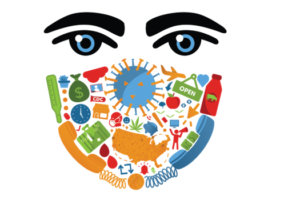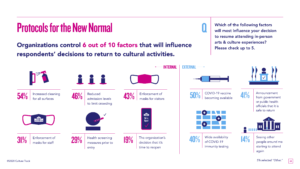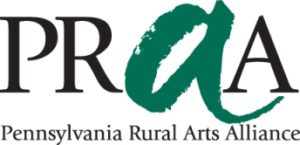Arts Organizations in the Time of COVID-19: Where We Are Now
Culture Track: Culture and Community in a Time of Crisis
 LaPlaca Cohen is a strategy and marketing firm for the creative sector that conducts and publishes research every 3-4 years on audience motivation for participation in the cultural sector. Their study “Culture Track” has been helping cultural organizations understand the changing behavior of audiences over time, including what types of cultural activities they were participating in and also what was keeping them from participating in culture. Their most recent findings were published in 2017.In April and May of 2020, Culture Track: Culture and Community in the Time of Crisis surveyed both the general public and those on the mailing lists of hundreds of arts organizations. In July they published their findings of how audiences were responding to COVID-19, and how they anticipated taking part in arts and culture going forward. While we encourage you all to read the full report, here are some important statistics:
LaPlaca Cohen is a strategy and marketing firm for the creative sector that conducts and publishes research every 3-4 years on audience motivation for participation in the cultural sector. Their study “Culture Track” has been helping cultural organizations understand the changing behavior of audiences over time, including what types of cultural activities they were participating in and also what was keeping them from participating in culture. Their most recent findings were published in 2017.In April and May of 2020, Culture Track: Culture and Community in the Time of Crisis surveyed both the general public and those on the mailing lists of hundreds of arts organizations. In July they published their findings of how audiences were responding to COVID-19, and how they anticipated taking part in arts and culture going forward. While we encourage you all to read the full report, here are some important statistics:
Effects of COVID-19
- In May 2020, 12% of those surveyed had either had COVID-19 or knew someone who had it. *It is important to note that in the last several months, the number of cases in the US has risen substantially so this number has also likely risen.
- 40% of participants reported a partial or complete loss in income. While reopening has since occurred in many states, it is important to note that the national unemployment numbers have not fully recovered and that the temporary increases in unemployment were halted in August, so there are likely still large portions of the population struggling financially.
- The Study also notes that according to their statistics, the COVID-19 crisis has disproportionately affected people of color and younger generations.
Digital Content
- Participants noted that after getting out of their homes, they were missing experiences that connected them with other people.
- 53% of survey participants had reported consuming digital cultural content. The top five activities were pre-recorded performances, live-streams, online classes, online engagement for children, and listening to podcasts.
- Virtual content was seen by many participants as more physically and financially accessible than live in-person performances
Returning to in-person
- Culture Track reports that even “after weeks of quarantine, respondents are eager to reconnect with loved ones and dine out, but aren’t as excited to resume most cultural experiences,” and few participants (only 31%) had done any planning to return to cultural experiences
- When asked what factors would contribute to their decision to return to in-person cultural participation there were ten total factors that would affect these decisions. A few of these include: increased cleanliness of all surfaces, enforcement of masks for visitors, and wide availability of COVID-19 vaccine being available. The chart below shows all ten factors. Click here for a bigger image.

In these rapidly changing times, it is important for organizations to know how they can best serve their audiences. Culture Track has provided a useful tool for measuring the behaviors and mindsets of our audiences, so that we might better predict their wants and needs. Please visit the Culture Track website for more info, past reports, and tools to interact with their data!
Going forward PRAA will continue to offer information on COVID-19 and ideas and strategies to help arts organizations remain in the public eye.
Recent News
- Creative Health Impact Grant Open for the 2024-2025 Year April 22, 2024
- Folkway Feature – Meet the Artist Joe Grkman Jr. March 12, 2024
- Opportunities in the Arts Event December 1, 2023
- Quilting: A Strong-Held Tradition in Armstrong County September 8, 2023
- Intangible Cultural Heritage – What is it? July 14, 2023
